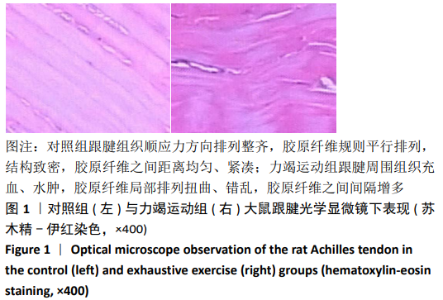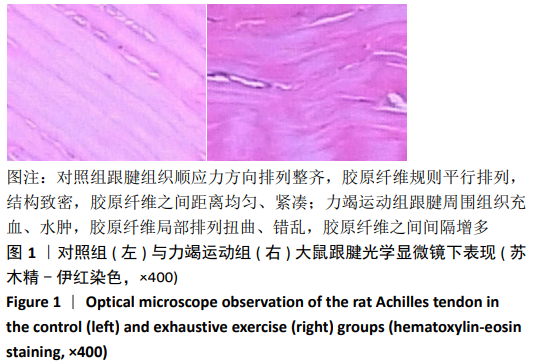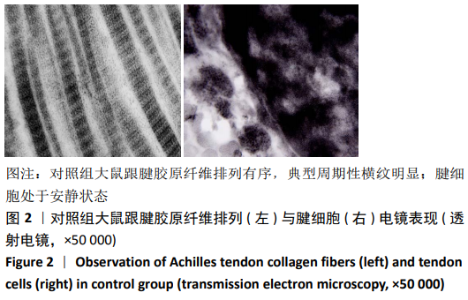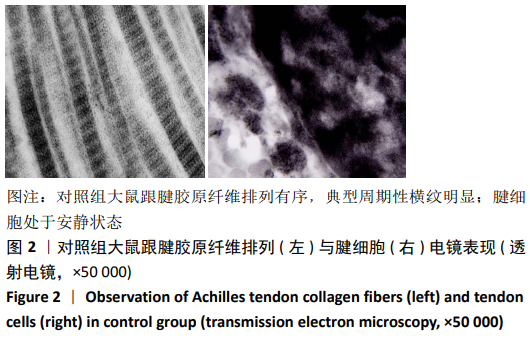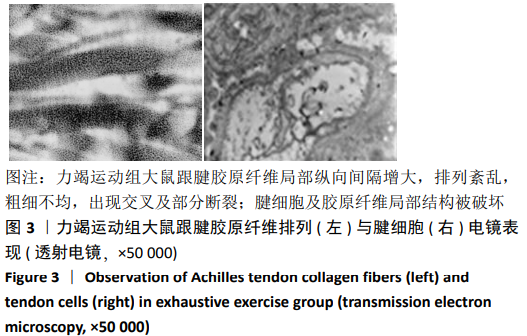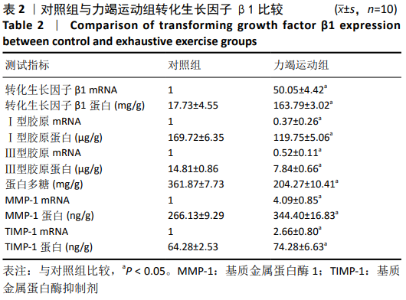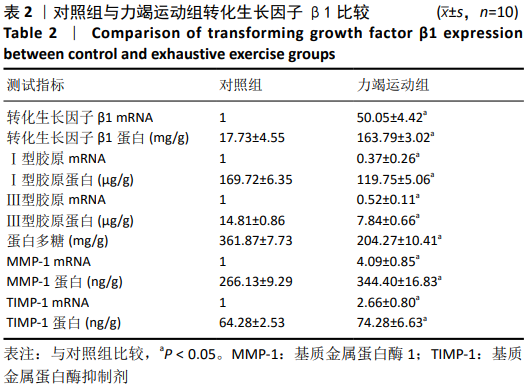[1] LONGO UG, PETRILLO S, MAFFULLI N, et al. Acute Achilles tendon rupture in Athletes. Foot Ankle Clin. 2013;18(2):319-338.
[2] 饶志坚,常芸,王世强,等.长期大强度耐力运动对心脏的不利影响[J].体育科学,2016,36(6):46-54.
[3] 刘晓莉,罗勇,乔德才.大鼠一次性力竭跑台运动模型的建立与动态评价[J].中国实验动物学报,2012,20(3):25-28.
[4] 赵俊,邹任玲,胡秀枋,等.大鼠跑台训练模型方法研究进展[J].动物医学进展,2014,35(9):101-105.
[5] 郝颖华,赵兰,王莉等.RT-PCR法检测低度恶性纤维黏液样肉瘤FFPE组织中的融合基因[J].临床与实验病理学杂志,2019,35(2): 228-230.
[6] 胡玉懿,吴蕙,韩序,等.ELISA双抗体夹心法检测嗜铬蛋白A的性能评价及临床应用[J].检验医学,2018,33(1):55-59.
[7] 沈勇伟.低功率激光对末端病大鼠跟腱修复作用及其机制研究[D].苏州:苏州大学,2012.
[8] 陈晓蓝,梁孝天,张宁,等.腱止点过度使用性损伤形成过程中细胞外基质的调节机制[J].中国组织工程研究,2020,24(20): 3174-3179.
[9] LUI PPY, CHAN LS, LEE YW, et al. Sustained expression of proteoglycans and collagen type III/type I ratio in a calcified tendinopathy model. Rheumatology. 2010;49(2):231-239.
[10] SODERSTEN F, HULTENBY K, HEINEGARD D, et al. Immunolocalization of collagens (I and III) and cartilage oligomeric matrix protein in the normal and injured equine superficial digital flexor tendon. Connect Tissue Res. 2013;54(1):62-69.
[11] 史晓伟,周学兰.转化生长因子β1多效性与肌腱修复研究进展[J].中国运动医学杂志,2016,35(6):588-593.
[12] 王尉,何恢绪,彭心昭,等.转化生长因子-β1对肌腱细胞DNA及胶原合成的影响[J].中华创伤杂志,2001,17(10):618-619.
[13] HEINEMEIER K, LANGBERG H, OLESEN JL, et al. Role of TGF-beta 1 in relation to exercise-induced type Ⅰ collagen synthesis in human tendinous tissue. Appl Physiol. 2003;95(6):2390-2397.
[14] 刘春雨,韩小燕,王琳.末端病与细胞外基质:骨腱结合部重要蛋白及酶类的关系尚需深入研究[J].中国组织工程研究,2016,20(15): 2265-2272.
[15] FU SC, CHAN BP, WANG W, et al. Increased expression of matrix metalloproteinase 1 (MMP1) in 11 patients with patellar tendinosis. Acta Orthop Scand. 2002;73(6):658-662.
[16] LANGBERG H, SKOVGAARD D, PETERSEN LJ, et al. Type I collagen synthesis and degradation in peritendinous tissue after exercise determined by microdialysis in humans. J Physiol. 1999;15(521Pt): 299-306.
[17] 史晓伟,龙丽娟,沈勇伟,等.末端病大鼠跟腱超微结构、胶原、MMP-1及TIMP-1的研究[J].中国运动医学杂志,2014,33(9):902-906.
[18] 高尚,唐康来,张吉强,等.不同强度跑台训练对大鼠跟腱微损伤修复影响的实验研究[J].中国修复重建外科杂志,2017,31(5): 574-581.
[19] 李敏,张林.跑台运动对大鼠跟腱形态结构和生物力学性能的影响[J].体育科学,2009,29(1):72-76.
[20] 胡亚哲,扈盛,王梅.大鼠跟腱末端病的细胞凋亡的检测[J].中国中医骨伤科杂志,2000,8(1):9-11.
[21] TSUBONE T, MORAN SL, SUBRAMANIAM M, et al. Effect of TGF-beta inducible early gene deficiency on flexor tendon healing. Orthop Res. 2006;24(3):569-575.
[22] 夏长所,洪光祥,杨选影,等.转化生长因子-β1对肌腱腱鞘、腱外膜和腱内膜细胞增殖和胶原产生的影响[J].中华实验外科杂志, 2006,23(9):1109-1111.
[23] 华卫平.适量运动对大鼠跟腱复健有促进效应[J].基因组学与应用生物学,2018,37(10):4647-4654.
[24] 张前法,杨志明,彭文珍.兔自体肌腱细胞与碳纤维联合培养后体内植入实验研究[J].中华修复重建外科杂志,1997, 11(3):44-47.
[25] 申晋波,张林,沈勇伟,等.力竭大鼠跟腱低功率激光照射前后IGF-Ⅰ及胶原含量的变化[J].北京体育大学学报,2017,40(11):56-61.
[26] 李敏,王平,张林.急性跑台运动对大鼠跟腱胶原合成和IGF-I的影响[J].天津体育学院学报,2009,24(4):303-305.
[27] NAGASE H, VISSE R, MURPHY G. Structure and function of matrix metalloproteinases and TIMPs. Cardiovasc Res. 2006;69(3): 562-573.
[28] BRAMONO DS, RICHMOND JC, WEITZEL PP, et al. Matrix metalloproteinases and their clinical applications in orthopaedics. Clin Orthop Relat Res. 2004;428(428):272-285.
[29] HAWINKELS LJ, KUIPER P, WIERCINSKA E, et al. Matrix metalloproteinase-14 (MT1-MMP)-mediated endoglin shedding inhibits tumor angiogenesis. Cancer Res. 2010;70(10):4141-4150.
[30] 李敏.跑台运动对大鼠跟腱的影响及其机制研究[D].苏州:苏州大学,2008. |
